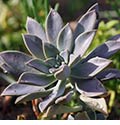Interdisciplinary green roof growing atop Langford building
A section of the Langford A building’s rooftop was transformed fall 2012 into a green roof with succulents, grasses and a weather station by an interdisciplinary group of Texas A&M students in phase one of a three-year research initiative.
The three-year, $300,000 [project] (http://one.arch.tamu.edu/news/2012/4/4/dvorak-greenroof/) is led by Bruce Dvorak, assistant professor of landscape architecture, Don Conlee, associate professor of atmospheric sciences and Astrid Volder, associate professor of horticultural sciences. It's funded by a Texas A&M Tier One Program grant aimed at enhancing students' preparation for the workplace and society through high-impact learning experiences.
“Large-scale green roofing across a campus or urban region is a way to mitigate the risk associated with urban land-use change,” said Cam Bartzen, an environmental studies major who helped install the green roof, on a project [blog] (http://tamugreenroof.wordpress.com) . “They allow urban areas to benefit from natural processes rather than being blocked from them. The vegetative cover absorbs carbon monoxide, cools buildings in the summer, insulates them in the winter and increases local biodiversity,”

Green roofs also absorb storm water and decrease runoff, improve air quality and turn an unused space into a potential commercial or recreational space.
Students built the green roof from scratch, propagating plants, building modules, installing roof protection tiles, a drainage layer, soil, an irrigation system and the weather station.
“Most of the plants are succulents, which are very good at conserving water,” said Kirk Laminack, a graduate horticulture student who helped install the green roof. “They keep a lot of water in their stems and conserve it so they can survive droughts.”
Succulents, he added, are accustomed to hot climates but sometimes the winter is what kills them, not the summer, because it gets too cold.
“The species we planted are limited not only by heat and rainfall but by the thinness of the substrate we’re using,” said Teresa McIntyre, a horticulture major. “Using just a few inches of substrate is an important part of the experiment because many people who want a green roof cannot afford the higher cost of using deeper soil and most buildings cannot handle the added weight.”
The weather station on the roof will keep track of weather conditions.
“I’m now confident I can build a greenroof without instructions and I understand the science behind its environmental benefits,” said Bartzen.
The project builds on Dvorak’s earlier Langford green roof [research] (http://archone.tamu.edu/college/news/newsletters/spring2009/stories/Dvorak_greenroof.html) , which he began in 2009.
Installation is scheduled to continue in the spring 2012 semester with the addition of herbaceous plants, which die completely at the end of the growing season or when they have flowered or fruited, and then grow again from seed.
The project also calls for students to design and build a living wall, a vegetated wall that achieves benefits similar to green roofs and investigate its performance.
Tags
- academics
- building a better texas
- feature
- graduate work
- interdisciplinary
- landscape architecture & urban planning
- laup gallery
- partnerships
- research
- rss
- sustainability
- technology
- video
Related Posts

A&M researchers collaborate in U.S. resilience center

Innovative ‘green’ wall features sheet metal, native plants

Zhu heading physical activity study project
Follow Us
Facebook Twitter Vimeo Youtube Flickr RSS
Recent Posts

Planning prof heads study of disaster housing aid

A message from the dean

Former student remembered as expert planner

Leading educator named new head of Architecture Dept.












_thumbnail_small.png)
